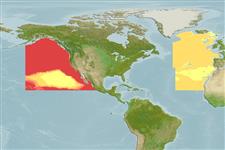Environment: milieu / climate zone / depth range / distribution range
Ekologi
laut batipelagis; kisaran kedalaman 400 - 1620 m (Ref. 50610). Deep-water; 66°N - 18°N, 160°W - 5°W
Eastern Atlantic: Madeira Islands. Eastern Pacific: British Columbia, Canada (Ref. 11980). Some records of Maulisia argipalla have been misidentified as Maulisia mauli.
Size / Weight / umur
Maturity: Lm ? range ? - ? cm
Max length : 19.5 cm SL jantan/; (Ref. 96339)
Meso- and benthopelagic at 850-1500 m (Ref. 58302).
Life cycle and mating behavior
Maturities | Reproduksi, perkembang biakan | Spawnings | Egg(s) | Fecundities | Larva
Quéro, J.-C., T. Matsui, R.H. Rosenblatt and Y.I. Sazonov, 1984. Searsiidae. p. 256-267. In P.J.P. Whitehead, M.-L. Bauchot, J.-C. Hureau, J. Nielsen and E. Tortonese (eds.) Fishes of the north-eastern Atlantic and the Mediterranean. UNESCO, Paris. Vol. 1. (Ref. 6682)
Status IUCN Red List (Ref. 130435)
ancaman kepada manusia
Harmless
penggunaan manusia
Alat, peralatan
laporan khas
muat turun XML
Sumber internet
Estimates based on models
Preferred temperature (Ref.
123201): 3.4 - 7.5, mean 5.8 °C (based on 93 cells).
Phylogenetic diversity index (Ref.
82804): PD
50 = 0.5312 [Uniqueness, from 0.5 = low to 2.0 = high].
Bayesian length-weight: a=0.01122 (0.00514 - 0.02450), b=3.04 (2.87 - 3.21), in cm total length, based on all LWR estimates for this body shape (Ref.
93245).
Trophic level (Ref.
69278): 3.4 ±0.5 se; based on size and trophs of closest relatives
Daya lenting (Ref.
120179): sedang, Waktu penggandaan populasi minimum 1.4 - 4.4 tahun (Assuming tmax>3).
Fishing Vulnerability (Ref.
59153): Low vulnerability (14 of 100).
